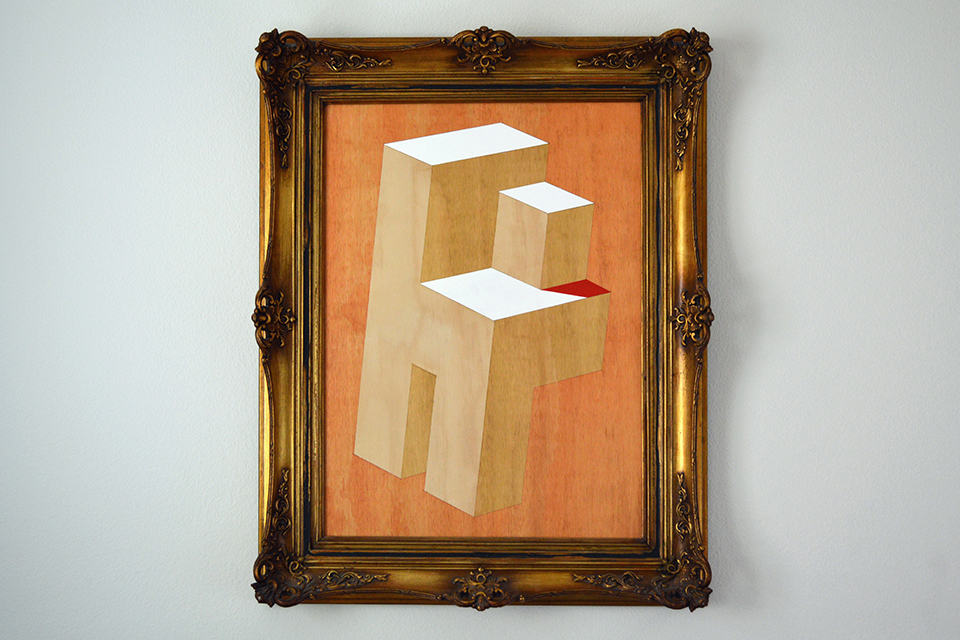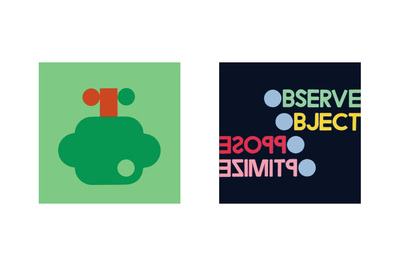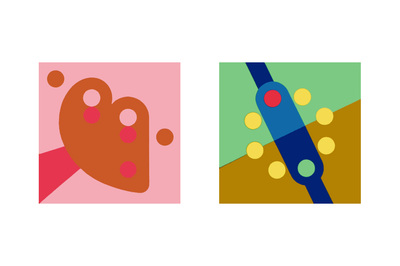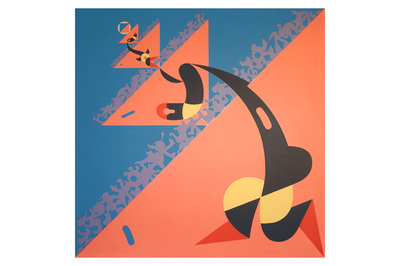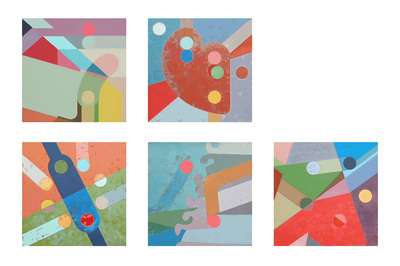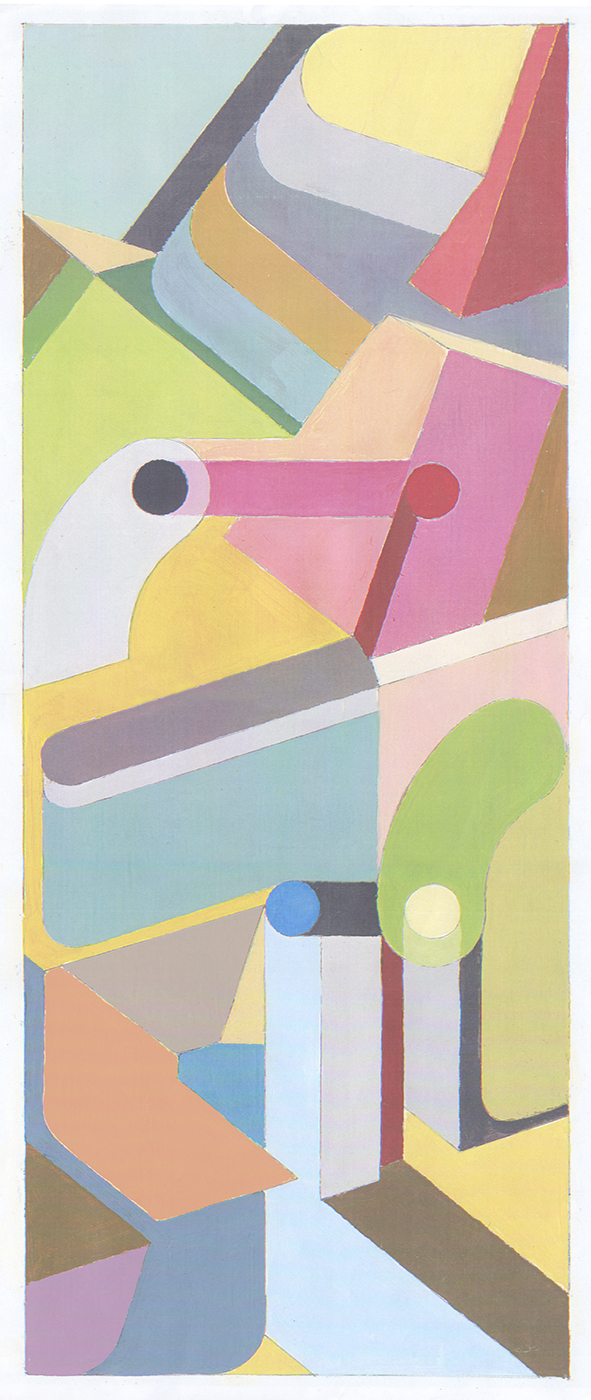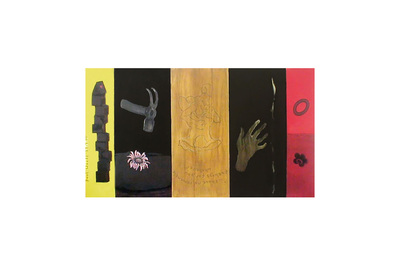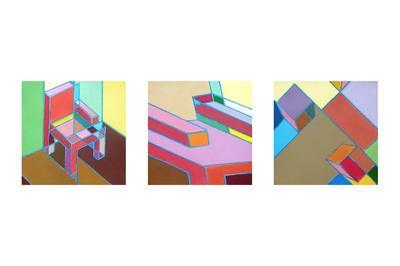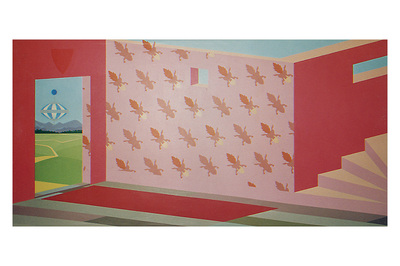PAINTINGS
Since 1999
"ZBC #3" above was made in 2012 and depicts what I considered a milestone in my experiments on wood. But I soon abandoned the series (or rather, postponed it indefinitely) unwilling to be bound again to masking, cutting out templates and so on. It is one of the few paintings still in my possession, and hangs both proudly and mournfully, depending on my mood, on a wall in Zurich. After this (and after the Chapel of Atheism) I moved on to sculpture.
I began painting on canvas in Berlin in 1999 after years of painting on walls (see murals). Using acrylics, the style was flat, involving lots of measuring and masking (first pictures below). Later I freed up and worked with oils, until only the strong use of symbolism remained recognisable. Simplicity went out the window with Cliff Falls on which I worked on and off for years. (It is still unfinished.) Documentation in those days was not a priority and few photos exist of works lost, sold or given away over time, so apologies for the poor quality of the images. Worth mentioning, too, is a careless tendency to paint over previous works, signifying lack of funds and therefore materials, as much as a constant striving for perfection (which, on consideration, I was not a million miles from on perhaps three occasions).
Texts
The following texts refer to some of the paintings above, written for exhibitions, funding applications or the blog. In retrospect they seem pedantic and arguably need not have been written in the first place. They usually confuse an already complicated issue. But in my struggle to get on as a painter, I found it irksome that people seemed so often bemused by my work, curators as much as the public. So I attempted to clarify in words - something I rarely do now.
Learning Games for Babies
1999, acrylic on canvas, 1m x 1m (x 10)
A series of ten paintings in which the first and last in the sequence represent quotation-marks and each of the enclosed panels represents a letter of the alphabet, adding up to a simple phrase.
Trick question: How do six billion human individuals solve the planet's multitude of problems (assuming they can even agree on what they are) when the majority are in no condition to be concerned with anything but vital needs, and the rest are happy to ignore the "gathering storm" so long as their own comforts are not compromised?
Simple equation: Each time a human-being washes its hands of a universal dilemma on the grounds that it is insoluble, the chances of the species overcoming its hardships are reduced by the utmost significant number: one.
Example: While an adult confronted with a series of apparently complex problems fails to see the answer staring him in the face, or refuses even to see the problem, a child is able to arrive at the crux of a matter at a glance.
Clue: The phrase might be the first two words uttered by a new born baby as it surveys the awaiting world and puts voice to the most basic instinct...
Collaborational Damage
1999, acrylic on canvas, 2m x 0.8m (x 6)
Locked into a mode of fast-forward, the human race is leaving itself less and less time to consider the consequences of the manifold undermining and irreversible changes it is imposing on a planet clearly straining under the burden. Few of its members learn anything to be put to significant use in one lifetime from the inconsistencies and follies of a species running mad on its own success.
* Cherry for the Cake
A last mountain peak of humanity rises out of the flood to puncture a poisoned sky: survival depends upon capturing the ripe resources of the stars...
* The Pie Makers
A bomb of humans falls upon a house of humans, to be caught freeze-frame in bright and passive media lights. It is caught also by the roof-straddling peace-maker who finds himself atop of "Hit List #3".
* Man with Squirrel
Minor news item from Spring, 1999: "Up to 2000 squirrels fed live into industrial shredder at Amsterdam airport due to paper-work problem." (Declared invalid, the task of the cargo's disposal was delegated downwards...)
* Hit List (#1 & #2)
The global shoot-'em-up: cross off a line and annihilate a race (#1) or a species (#2)
* Bullet Baby
Full title: "Man with boots and head wound assaulting tear-shaped praying woman with body wound by means of atom-bomb fart (thus) kick-starting birth of bullet baby."
Stomach Problem
1999, acrylic on canvas, 1.4m x 1.4m
A construed fantasy in which the Animal World graphically exhibits its contempt for mankind.
Contempt is a human vice: when grafted onto the image of an animal that animal is immediately contaminated and diminished. It is in the nature of man to diminish all other life-forms on this planet. The artist accepts his share of the responsibility, in this case by acknowledging that the anthropomorphic representation of animals is a symptom of the destructive process as a whole. Caricaturization is at the very least a form of disrespect, intended or not. The simplified image of Mickey Mouse has helped disrupt our concept of the living mouse, which is an animal as legitimate in the world as a horse (a creature generally diminished by other means) or a human being. Example: the painting, deliberately decorative in style, often provokes an initial response of pleasure. An animal's pain is overlooked even as it is petted and closely observed.
The painter spells it out in words: The Animals heads are retrieved from the trophy wall and pinned back onto their cloned and misshapen carcasses using, as pegs, the unnatural pills they have long been forced to consume (doctored foodstuffs, genetic tampering, experiment, the pill of humiliation). The figures spin on man's ingenious invention of torture and death; a spiked iron sausage-making machine in the form of a swastika, upon which he himself is now crucified. The device swallows up the remaining members of his own family, as they habitually and greedily cling to the rag-doll off-spring of the parent animals, themselves now at the old masters helm.
The brutalization and destruction by mankind of all his fellow creatures great and small is an aspect of fascism which, contrary to that inflicted upon his own species, is widely ignored and goes almost completely unchallenged (i.e. passive fascism).
The rapid disintegration of the planet itself is a supreme example of the Fascism of Man. The phenomenon cannot be described merely as self-destruction, for man is not content to destroy only himself. If he believes in God, he is attacking all God's earthly Creation, and therewith God Himself.
The Eternal Eclipse
1999, acrylic on canvas, 1.4m x 1.4m
No one figure in the scene is aware of much of what is passing, or has passed, or will pass around, or before, or after him. Each horizon (past, present or future, imagined or otherwise) is crammed to over-flowing with the antics of Fascist Man who, oblivious to the antics of his relative neighbour, struts among the remnants of the planet's remaining beasts, which he naturally and proudly dominates into the dust. The large figure (individual or collective knowledge, or imagination, or the artist, or Mickey Mouse) extends to cross the rigid boundary of the present (or of reality, or of conformity, or of nonsense) to contact his relation; a baby (his future, or his past, or his legacy). That figure in turn connects with its own future (or past, or ideal, or nightmare) and is therefore at once both giving and receiving. But giving and receiving what?
The substance of the message the figures pass back and forth to one another is left to the ingenuity of the observer to fill in for themselves. Thus he or she is obliged to become the key figure in the work, which has no boundary: imagine the whole as a collage of coloured paper cut-outs; moveable elements (note the key-slots) each of which can be slightly but significantly manipulated, thus affecting the symmetry (or constellation, or destiny) of the other elements, and of the vision as a whole. A small tolerance is therefore achievable as the observer, presuming at last to participate, makes physical contact with the lower right-hand corner of the canvas and projects him or herself for a moment (or for eternity) into the Position Of Power (POP!).
(For the artist himself, the message is the solution to his own existence, but is written across the face of the moon which is in Eternal Eclipse.)
The Serb
2001, acrylic on canvas, 1.2m x 2.4m
The confusing history of an unfinished, un-titled, unimportant painting.
No new works to show off at THE WORLD'S END EXPERIMENT LABORATORY exhibition in Prenzlauerberg, Berlin, in November 2001.
Decided instead to hang this painting for cross-examination and to fill the white wall.
Bedroom.
Looking into the history of this never-to-be-completed work is to track the course of the artist's intentions, developments and frustrations over the two and a half years since its grand beginnings in a bedroom in Paul Robeson Street.
Setting Out.
Aim was to construct the image of a three-dimensional room in a believable world using geometrical perspective, and to marry it with the styles of that time,
i.e., flat, abstract, comic. The setting should be a child's room, anywhere, which is also a bunker in the former Yugoslavia.
The Serb.
The attempt to create an environment, both in painting technique and in reality, in which to introduce and integrate portrait painting to the developing style.
The subject, that strange Serbian acquaintance, Isidor, has proven too illusive ever to have been imprisoned within the awaiting background. But he may be captured yet.
Discovery.
The texturing of surfaces and differing treatments of various objects as a means of enhancing depth and perspective of the scene as a whole.
The exhibition at Dresdner Bank in 2000 included re-worked pictures from the series "Learning Games for Babies". These were painted-over as test pieces for continuing work on "Isidor the Serb".
Embassy.
The painting, with another new title, was included in my application for the doomed open-air art project "Art Embassy at the Reichstag" (2001). By the time the application was turned down, the scene now depicted in "The Child's Room" had absorbed references to the Embassy project as well as to works of other artists involved. Many of the additions were pasted on in collage fashion.
The landscape beyond the bunker had always symbolised the aftermath of battle, or the still before the apocalypse (the spinning-top mushroom-cloud). The addition of a Don Quixote puppet resting forlorn in the gateway summed up pretty well this organiser's feelings at the end of another industrious, hopeful, stressful, disappointing, stoned and penniless summer.
Update, November 2002.
Finding myself between homes this year, my trusted friend Corinne volunteered to store the painting on top of the filing cabinet at her band-booking office in Friedrichshain. She sent an e-mail: "A bit brain damaged today. No news. I just about rescued your painting from the office. Tom had given it to his roommate, she was going to paint over it. They also threw all the Kultuhr paperwork and important tax forms into the bins so we had to get them out again. Bastards."
Update, September 2006.
The picture decorated Corinne's bedroom for some years before I collected it. I removed it from the frame and rolled it up - the swastikas visible in the carpet acquiring curious looks as I fumbled with it on the Berlin subway - for the opening of Berlin Big Chairs (aka BBC) which opened at Gallery Wallywoods in Kreuzberg on July 1, 2006. The picture was then sold in August to newly-weds Cord and Birgit for 500 euros. Amazing. On September 9, newly stretched on a sturdy frame locally constructed for 70 euros, it starred at the closing BBC event. It was slightly altered again during a small concert (I often painted behind a performer or band) and a large American appeared to wish to buy it for 4,000 euros. This would have broken all records and paid some debts. However, the money already received from Cord and Birgit did in fact break all previous records, and I am happy enough.
Even though it is still unfinished.
"A small man can be just as exhausted as a great man." Arthur Miller
Cliff Falls
Oil on canvas, 1m x 2m, 2004 - 2006
Breakthrough in the garage.
The Cliff Falls picture swims in and out of focus depending on the evening mood, the cold coming under the door, the cycle of depression, weed reserves. One day its my masterpiece, the next, kiddy crap. I paint all night for a week, then can't stand to go in the garage to look at it. But there are intense moments of encouragement. Today I cracked a key part of the code. I found I could choose the right colour and put it in the right place in just about the right way. Its like when the magic eye picture miraculously clicks into 3D for the first time. And suddenly I can look at other paintings and understand better how they were put together, to know where their life comes from. The style that has emerged from using oils, in this fantasy illustration way at least, is different from anything I've done. It's flat and sculpted at the same time. Both garish and subtle. It includes bits of everything I've learned with acrylics and other materials including poetry, music, well whatever. I can't easily paint a landscape in a classical way, but I can imagine a landscape as a ceramic object and paint that, as I've always been able to copy pretty much anything. (I should forge some Euros one day.) Most of the learning is done sitting in the chair looking at the bloody thing for hours, sometimes for most of the night. The rest is repairing mistakes and solving puzzles. Finishing this picture is the hardest thing I've ever done. Its a full time job:
On the right-hand cliff at Lucombe Bay the lighthouse beams inland to illuminate a monastery-prison, which has no roof, and appears to slide down the left-hand cliff. A semi-wreath of wrecked ships decorates the bay beneath the lighthouse. A siren is carved in the chalk there. Her wings are spread and she has no head, only the tits and thighs remain; but they are apparently enough to lure the boatmen. Nestled between the breast-like cliffs, under the necklace rainbow, is a satellite dish aimed at the full moon, which might also be the earth turned up-side-down shortly after the next magnetic flip. (I've become addicted to fascinating TV documentaries.) The lighthouse is also a Tate gallery, a mosque, a synagogue, Noah's Ark, and a hotel with a landing platform. To the far right, space shuttle Columbia attempts to land on the calm sea, water-skis attached. Upon a communications mast are strung up, like dirty washing, geometrical paintings from my own colourful past. They signal something... but who knows what, or to whom. (Planet Columbia was terraformed after a good Max Ernst documentary.) This island planet is the first SPACEVAC destination furnished with welcoming Jesus, big wheel, standing stones, atom-bomb-fart-tree, Three Prince's Waterfall, cow with leaky udders and a crumpled Dr Pepper can. Some white sand-dunes and much of the foreground have been cordoned off with red and white builder's tape (not police tape or burglar's tape) whilst DO NOT THIS OR THAT road signs clutter the scenery. In the water below sheer cliffs at the extreme left, bedraggled bathers attempt to haul themselves ashore. So far they are a fat red-headed woman, a tattooed strongman and a decent blond. Nearby, a black upright piano is tied off halfway up the treacherous stone steps, which lead to the vagina cave hidden in the Fairy Forest. It's all perfectly real. Above that, in silence under the umbrella tree beneath a rainbow, a cultivated lady sits amidst the drizzle and the sun-set. She purposefully interrupts the lighthouse-beam until her profile daubs a huge silhouette onto the monastery-prison wall.
There is no sign of the prisoner, but the weather cock is the symbol of Om.
And I would like to paint my old red convertible TR7 on the landing platform to add a fantastic touch.
(I spent a full year in my parents garage on the Isle of Wight working on Cliff Falls. Eventually I rolled it up and took it to Berlin, where it has been in storage since I moved to Zurich. I hope to pick it up one day - if it is still where I think it is - and perhaps even finish it. At some point, frustrated again with paint, I turned part of it into a digital poster.)
Concerning the photo from the Deichtorhallen Expo in Hamburg, 1999
Took some paintings up to the grandly named Grand Marché for Contemporary Art, this time in Hamburg. Looked at them for five days then took them home again. The woman sitting in the chair is another artist who did not sell. She brought her work all the way from from Finland, along with furniture and a very pretty professional interpreter. She sat there like that - miserable - the whole time. Unlike myself, who shared a flat in Berlin with one of the event organisers, she paid the full price for her hanging space: an expense I could not possibly have afforded.
|
#Paintings #ParadoxPaul |
